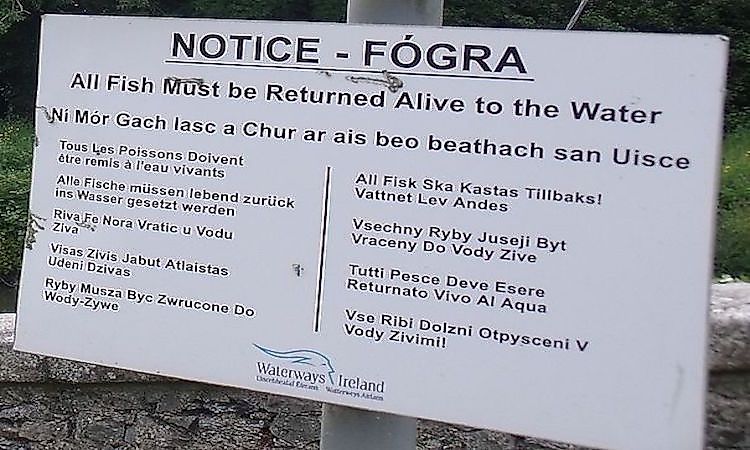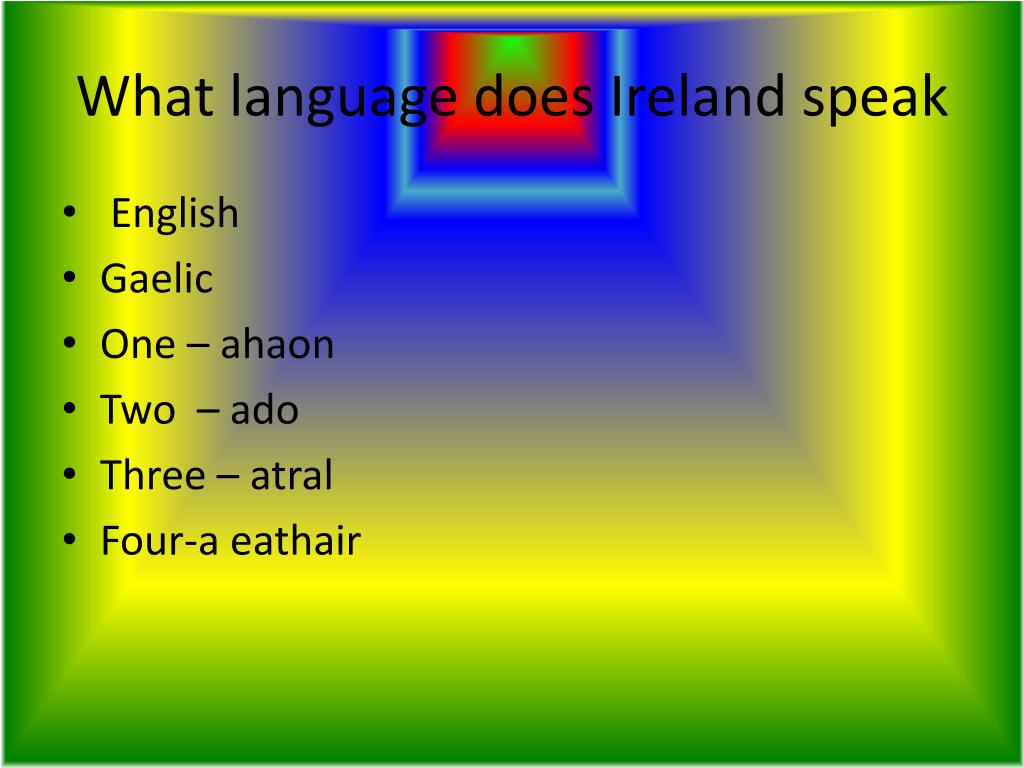What language does Ireland speak? This question unveils a fascinating tapestry of linguistic diversity, historical influences, and cultural revival. Embark on a journey to discover the official languages, regional variations, and ongoing efforts to preserve and promote the Irish language.
Ireland’s linguistic landscape is a testament to its rich history and cultural heritage. From the ancient Gaelic tongue to the widespread use of English, the languages spoken in Ireland have shaped its identity and continue to play a vital role in its present-day society.
Official Languages of Ireland: What Language Does Ireland Speak

Ireland has two official languages: Irish (Gaeilge) and English. Irish is the national and first official language, while English is the second official language.
The Irish language has a long and rich history in Ireland, dating back to the arrival of the Celts in the 5th century BC. It was the dominant language of Ireland until the Norman invasion in the 12th century, after which English gradually became the language of government and commerce.
Legal Status and Recognition
The status of Irish and English as official languages is enshrined in the Irish constitution, which states that “the Irish language as the national language is the first official language, and that the English language is the second official language.”
This means that all official documents and communications from the Irish government must be published in both Irish and English. The Irish language is also used in education, broadcasting, and the courts.
Examples, What language does ireland speak
Here are some examples of official documents and communications in both Irish and English:
- The Irish constitution
- The Irish passport
- Irish government websites
- Irish road signs
- Irish banknotes and coins
Regional Language Variations
The Irish language exhibits regional variations in its dialects, reflecting the diverse cultural and historical influences that have shaped Ireland throughout its history. These dialects are primarily spoken in rural areas and have distinct linguistic characteristics that set them apart from the standard form of Irish.
The main dialects of Irish can be classified into three broad categories:
Connacht Dialect
The Connacht dialect is spoken in the western province of Connacht, including counties Galway, Mayo, Sligo, and Roscommon. It is characterized by its use of the slender /s/ sound (written as sh) in words that have a broad /s/ in other dialects.
For example, the word sean(“old”) is pronounced sheanin Connacht.
Munster Dialect
The Munster dialect is spoken in the southern province of Munster, including counties Cork, Kerry, Limerick, Waterford, and Tipperary. It is known for its distinctive intonation and the use of certain vowel sounds that differ from other dialects. For example, the word bó(“cow”) is pronounced with a long /o/ sound in Munster.
Ulster Dialect
The Ulster dialect is spoken in the northern province of Ulster, including counties Antrim, Armagh, Derry, Down, and Tyrone. It is characterized by its use of the broad /a/ sound (written as ah) in words that have a slender /a/ in other dialects.
For example, the word arán(“bread”) is pronounced arahnin Ulster.
These regional dialects play a crucial role in preserving the cultural heritage of Ireland. They reflect the unique linguistic and cultural traditions of different regions and provide insights into the history and diversity of the Irish language.
Irish Language Revival

In recent decades, there has been a significant effort to revive and promote the Irish language, which had declined in usage over the centuries. This revival has been driven by a combination of government initiatives, educational programs, and cultural organizations.
Government initiatives have played a crucial role in supporting the revival of Irish. The Official Languages Act of 2003 designated Irish as an official language of Ireland, alongside English. This act provided for the use of Irish in government, education, and the media.
Educational Programs
Educational programs have also been essential in promoting Irish language learning. The government has introduced Irish language immersion programs in schools and universities, providing students with opportunities to learn and use Irish in a real-world context.
Cultural Organizations
Cultural organizations have played a vital role in fostering a positive attitude towards the Irish language and promoting its use in everyday life. Organizations such as Conradh na Gaeilge (the Gaelic League) and Foras na Gaeilge (the Irish Language Agency) have been actively involved in promoting Irish through events, publications, and advocacy.
Challenges and Successes
The revival of the Irish language has faced challenges, including the dominance of English in Irish society and the lack of native Irish speakers. However, there have also been significant successes. The number of Irish speakers has increased in recent years, and there is a growing awareness of the importance of preserving and promoting the language.
Irish Language in Education
The Irish language holds a significant place in Ireland’s educational system. The government has implemented various measures to promote and preserve the language, including making it a compulsory subject in schools and establishing Irish-medium immersion programs.
Compulsory Irish Language Curriculum
The Irish language is a compulsory subject for all students in primary and secondary schools in Ireland. The curriculum aims to develop students’ proficiency in the language through reading, writing, speaking, and listening activities. The level of proficiency required varies depending on the grade level.
Effectiveness of Irish Language Immersion Programs
Irish language immersion programs have been implemented in schools across Ireland to provide students with an opportunity to learn the language in a more natural and immersive environment. These programs involve teaching all or most subjects through the medium of Irish.
Studies have shown that immersion programs can be effective in improving students’ Irish language proficiency and fostering a positive attitude towards the language.
Irish Language in Media and Culture

The Irish language has a significant presence in Irish media and culture, playing a crucial role in promoting and preserving the language.
Irish language films, television shows, and music have become increasingly popular in recent years, providing a platform for the language to reach a wider audience. Notable Irish language films include “An Cailín Ciúin” (The Quiet Girl), which won the Silver Bear for Best Screenplay at the 2023 Berlin International Film Festival, and “Arracht” (Monster), which was nominated for Best International Feature Film at the 2023 Academy Awards.
Irish Language Literature and Poetry
Irish language literature and poetry hold a deep cultural significance in Ireland. Classic works such as “An t-Oileánach” (The Islandman) by Tomás Ó Criomhthain and “Mise Éire” (I Am Ireland) by Padraig Pearse have left an enduring legacy on Irish culture and identity.
Contemporary Irish language writers continue to produce acclaimed works, including poets such as Nuala Ní Dhomhnaill and novelists such as Éilís Ní Dhuibhne. These works not only showcase the beauty and richness of the Irish language but also explore themes of Irish history, culture, and identity.
Closing Notes
The linguistic journey of Ireland is an ongoing narrative, marked by both challenges and triumphs. The revival of the Irish language stands as a testament to the resilience and cultural pride of the Irish people. As the language continues to evolve and adapt, it remains an integral part of Ireland’s identity, connecting its past, present, and future.
Top FAQs
Is Irish a widely spoken language in Ireland?
While Irish is an official language, English is the dominant language spoken in Ireland. However, Irish is gaining popularity and is taught in schools.
What are the main regional dialects of Irish?
The main regional dialects of Irish are Ulster Irish, Connacht Irish, Munster Irish, and Leinster Irish. Each dialect has its own unique linguistic characteristics.
What is the status of Irish language education in Ireland?
Irish is a compulsory subject in Irish schools until the age of 16. There are also Irish-medium schools where all subjects are taught through Irish.